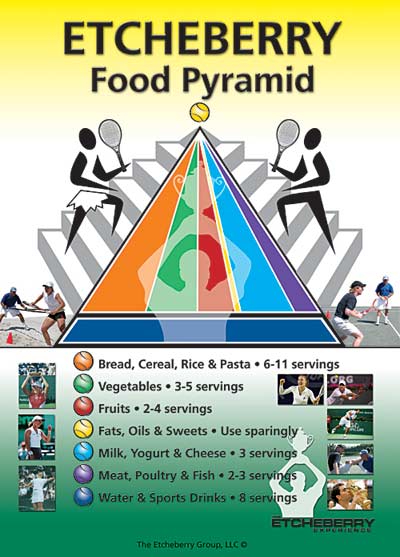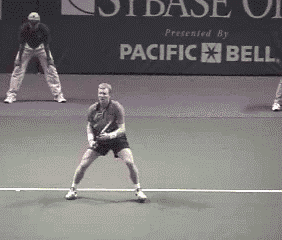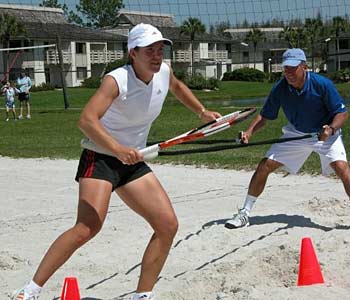
Champions Are What They Eat
Nutritional Tennis
Pat Etcheberry
You probably have heard the cliché “You are what you eat.” Cliché or not, it is absolutely true that if tennis players don’t maintain a proper daily diet to support all of the conditioning and training they do, their bodies can’t perform at an optimum level during crunch times. Put another way, champions are what they eat. And this is particularly true for junior players, whose bodies are still growing.
 Eating the right foods helps players maintain desirable body weight, stay physically fit, and establish optimum nerve-muscle reflexes. A player should have a healthy balance of carbohydrates, protein and healthy fats, but they have to be in the right amounts. The ITF recommends that carbs represent 60% of the calories in your diet, proteins only about 10-15%, and fat 20-30% (see ITF chart).
Eating the right foods helps players maintain desirable body weight, stay physically fit, and establish optimum nerve-muscle reflexes. A player should have a healthy balance of carbohydrates, protein and healthy fats, but they have to be in the right amounts. The ITF recommends that carbs represent 60% of the calories in your diet, proteins only about 10-15%, and fat 20-30% (see ITF chart).
Participating in sports can drastically increase a players’ food energy needs. Increased physical activity calls for more food calories. Also, when players train, they increase their muscle tissue relative to fat tissue, and muscle tissue requires more calories than fat tissue.
Going out for sports can easily increase the daily calorie needs of a teen athlete by 2,000 or more. And because of their rapid growth and development and higher levels of physical activity, many teen athletes should eat the higher levels of servings recommended from each food group -- especially from the grains group (bread, cereal, rice, and pasta) and the vegetable group.
What you eat every day affects your performance, and what you eat immediately before a match can be vital. The right foods at the right time can actually give you a competitive edge. Players of all ages need to eat the proper foods for days before a tournament to charge their muscles with glycogen. They need foods high in starch to help keep muscle energy up. If they don’t eat the right foods, their strength and energy levels won’t be at their maximum potential for tough, long matches or practices.
For a veritable smorgasbord of information and recommended meal plans, visit the University of Illinois Extension website: |
Coaches and parents should monitor a player’s weight, and if he or she loses body weight during a competitive season, it's a good indication that they aren't eating enough energy-providing food. Young athletes should be weighed once a week throughout the season to guard against unhealthy weight loss caused by inadequate food intake.
Hydration
Hydration is another sensitive area. Many coaches and athletes once believed that restricting water during a competition or practice session toughened an athlete -- that somehow athletes needed less water. Without enough water to cool itself, the body can overheat to dangerous levels.
As conditioned athletes, tennis players are able to store and burn more energy in a shorter time. That means their bodies release more heat, require more cooling, lose more water, and need more water to replenish its provisions. Also, they sweat more, which means they lose even more water. The truth is, well conditioned players need more water than other people.
 During the '90s, Pat Etcheberry trained, Jim Courier built an impressive career around superior conditioning, balanced nutrition, and a lethal forehand. |
Drinking moderate amounts of water at frequent intervals is the best strategy during competition or practice. A player should drink about six to eight ounces of cool water every 15 to 20 minutes during a match. Cool water (40 to 50 degrees Fahrenheit) is best because it helps absorb body heat and it empties from the stomach into the intestine at a faster rate, allowing it to be absorbed rapidly into the body. Water is the drink of choice for activity less than 60 to 90 minutes. But many tennis matches go beyond that time frame, and then sport drinks containing carbohydrates and electrolytes may offer players an advantage.
The goal of nutrition is to fuel your body for greater efficiency. Food should not be used as a reward or a punishment, i.e. dieting or feasting. All tennis players require a well balanced program which accommodates both on court and off court needs, but Juniors in particular need it to maximize performance now, and to minimize the potential for career altering injuries in the future.
Here are some additional websites where you can find more tennis-specific nutritional information from real experts, and more sample menus.
 Intensive conditioning and attention to diet transformed Justine Henin-Hardenne from a gifted tennis player into a champion. |
Sample Menus
PRE-MATCH MEAL
Lunch: (3-4 hours before competition)
Pre-Game Snack: (1-2 hours before competition)
POST-MATCH MEAL:
Or
These examples and a great deal of important nutritional information are available at www.usta.com/juniors/fullstory.sps?iNewsid=28344.
![]()
For more than twenty years Pat Etcheberry has been providing athletes from around the world with the winning edge. We call this the Etcheberry Experience, and players with an Etcheberry experience have hoisted Championship Trophies at over one hundred major championships, including 28 Australian Opens, 18 Wimbledons, 22 US Opens, 22 French Opens and 15 Olympic medals.
And now it's your turn! This is your chance to experience the same drills, exercises and words of tennis wisdom that Pat gave to Pete Sampras, Andre Agassi, Jennifer Capriati, Martina Hingis, Jim Courier, Justine Henin-Hardenne, and others, that helped launch them on their incredible careers. For the first time, Pat Etcheberry shares his training secrets in a series of DVDs for players of all ages, their coaches, and trainers.